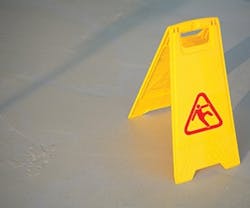Watch Out for Costly Claims from Poor Floor Upkeep
When it comes to floor safety standards, fall in line or risk falling from grace. Prevention is essential with slips, trips, and falls. Having protocol and products in compliance will safeguard against costly claims.
The American National Standards Institute (ANSI) appointed the National Floor Safety Institute (NFSI) to author floor safety standards in 2006, and although they are technically voluntary, many consultants and expert witnesses rely on them as a key resource in court claims.
“We’re not really talking about suggestions,” says Russell Kendzior, president of NFSI, adding that the ANSI/NFSI standards may become mandated by the Occupational Healthy and Safety Administration (OSHA) in the August revision of its regulations. “If you don’t comply and you happen to get sued, then your goose is cooked.”
Kendzior has acted as an expert witness for some 500 slip, trip, and fall cases. In one Dallas case the plaintiff was awarded over $4 million by the defendant, Minyard Food Stores Inc., which was not in compliance and subsequently went bankrupt. Here’s how you can avoid a horror story like that one.
Start with Standards
Beware of eco-friendly labels and focus on performance, says Claudia Lezell, hard surface division chair of the Institute of Inspection Cleaning and Restoration Certification, a non-profit organization that has developed standards in conjunction with ANSI and NFSI.
“With green and LEED certification, there’s been some debasing of standards, unfortunately. Not all of the products that earn points give the best results,” Lezell says. “There’s just not a one size fits all. You’re usually not slipping because of the floor, but a coating or cleaner on it.”
The ANSI/NFSI standards cover everything from flooring materials and auto-scrubbers to cleaning chemicals and mats. NFSI also certifies independent auditors and technicians. Using approved products and procedures will protect you (see sidebar for more details).
“Owners have an obligation to safeguard their environment, and these standards cover you in the event of an accident,” says Kendzior. “Slips and falls aren’t scams – the issue is real. You have to comply.”PageBreak
Prepare a Protocol
Everything starts with the specification, says Lezell.
“Sales reps are more interested in getting a product specified than getting it to perform, but approved cleaning protocol should be written into the spec,” she adds. “Put people on the spot. If they want their product sold, they need to tell you how it’s maintained. When a floor gets installed, an FM should get with the technicians and walk through step by step and learn the info without the sales pitch.”
The next step is establishing a cleaning schedule in terms of traffic flow and periodic maintenance vs. daily attention, Lezell says.
Zoning is also a helpful concept, adds David Collette, director of food service for Cintas Corporation, a service provider and manufacturer. “Identify zones like outside, entry, restroom, and common areas. Thinking in those terms helps you know what soils are present,” he says.
Simply changing your cleaning process might also make significant improvements.
“People think swishing a mop around is natural, but they don’t really know how to do it. It’s like brushing your teeth or doing laundry. You need solvent, a chemical, and agitation,” Collette says. “If you don’t do it properly, you’re just spreading dirt.”
Collette suggests a two-sided bucket for wringing dirty liquid. A distinction between wet and damp mopping is also necessary.
“Most people dip a mop in the bucket, wring it out, and then swish, but then you’ve wrung out the good stuff,” he explains. “If you’re picking up a spill, damp mopping is fine, but if you’re cleaning, you need the chemical to do its job.”
Documentation and follow-up is the last item. “A simple metric is a chart in restrooms where someone signs their initials. You need verification to make sure it’s working,” Collette says. “Periodic monitoring should be done by inspectors, just like with food safety. That’s the next step: involving OSHA and getting regulations in place.”
Audits and Avoidance
Materials perform under perfect conditions, but you can’t take the lab out into the field. “As an expert witness, I’m always showing people how something fails even if you think you’re doing everything by the books,” Lezell says.
Certified independent auditors can come to your building and identify problem spots for a fraction of the cost of a claim. An inspection for a grocery store might cost $5,000, Kendzior estimates.
“Tests can be done to show if your materials and products produce high, moderate, or low traction based on the coefficient of friction,” he adds. “If you’re in moderate or low, do something. And a lot of the times it’s very modest. Just change your cleaning procedures or adopt a new product line. It’s not like you have to chisel up your floor.”
Insurance companies are already telling their clients to get in compliance and some even reduce premiums if you have a safe environment, Kendzior adds.
“But if you have an event, your insurance will drop you or your premiums could double, triple, or quadruple,” he says. “Failure to know these standards is not a defense.”
Chris Curtland [email protected] is assistant editor of BUILDINGS.
